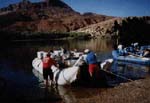AKA: none
Other ID: R-1-94-GC
Status: Completed
Organization(s):
Funding Program(s): Colorado River Sand Distribution Monitoring (MU063)
Principal Investigator(s): Roberto Anima, Mike Marlow
Affiliate Investigator(s):
Information Specialist(s):
Data Type(s): Imagery: Video, Seismics: Boomer, Seismics: Sub Bottom Profiler, Sonar: Sidescan, Sonar: Single Beam
Scientific Purpose/Goals: Four goals: 1. Image the river bed to determine areas within the pools where sediment accumulation is taking place using side-scanning sonar; 2. Image the thickness of the sediment accumulation over bedrock and talus; 3. Gather underwater video of the sediment type and bedform type imaged with the side-scanning sonar as groundtruthing; 4. Gather bathymetric profiling data to be used both for geophysical record interpretation and for mapping of the river bottom by personnel of Water Resources Division.
Vehicle(s):
Start Port/Location:
End Port/Location:
Start Date: 1994-04-19
End Date: 1994-05-13
Equipment Used: Kleinsidescan, Geopulse, underwatertelevision, bathymetry, mudseis
Information to be Derived:
Summary of Activity and Data Gathered: The cruise was a complete success. All sought after goals were met with excellent results from all systems used.
Staff:
Affiliate Staff:
Notes: Physical data holdings
Associated activities with Grand Canyon Sedimentologic Engineering: R-1-96-GC R-2-96-GC R-1-97-GC Associated activities with Colorado Sand distribution Monitoring: R-1-94-GC R-1-98-GC R-1-99-GC R-1-00-GC R-3-00-GC R-4-00-GC Cruise Summary Notes (modified from 5/27/94 USGS Bulletin) Recently returning from the Colorado River, Roberto Anima, Mike Marlow, Dave Hogg, and Kaye Kinoshita report that wind, rain, hail, and heat, were encountered during an extremely successful geophysical data collection cruise. The team collected digitized high-resolution geophysics and side-scanning sonar; fathometer, and underwater video to measure the extent of sediment stored along fourteen reaches of the Colorado River corridor. The project is part of the Grand Canyon Environmental Study (GCES) that is investigating the effects of fluctuating river discharge (controlled by Glenn Canyon Dam) on the rivers ecosystem. USGSs involvement is to look at the sediment supply along the corridor. The initial results of the survey revealed that approximately 3 to 9 meters of sediment cover bedrock or talus along many of the reaches, and that the amount of talus in the river, from the margins, greatly effects the amount of sediment cover. Dave Hogg, Fred Paine, Mike Boyle and the rest of the ET shop did an outstanding job of preparing all the electronics and boxing the equipment for the wet and bumpy conditions encountered in the rapids. Only two very minor wiring problems occurred during the 21 days of surveying.
Staff information imported from InfoBank
Roberto Anima (USGS Western Region) - Chief Scientist
Mike Marlow (USGS Western Region) - Chief Scientist
Location:
Colorado River
| Boundaries | |||
|---|---|---|---|
| North: 37.75 | South: 35.25 | West: -115.75 | East: -110.25 |
Platform(s):
 Raft |
Anima, R.J., Marlow, M.S., Rubin, D.M., and Hogg, D.J., 1998, Comparison of sand distribution between April 1994 and June 1996 along six reaches of the Colorado River in Grand Canyon, Arizona: U.S. Geological Survey Open-File Report 98-141, https://doi.org/10.3133/ofr98141.
| Survey Equipment | Survey Info | Data Type(s) | Data Collected |
|---|---|---|---|
| Kleinsidescan | --- | Sidescan | |
| Geopulse | --- | Boomer | |
| underwatertelevision | --- | Video | |
| bathymetry | --- | Single Beam | |
| mudseis | --- | Sub Bottom Profiler |